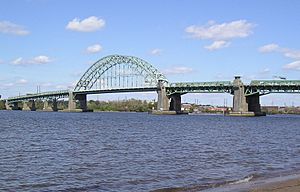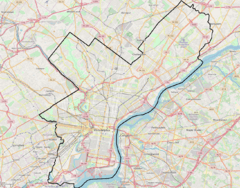Tacony, Philadelphia facts for kids
Quick facts for kids
Tacony
tèkhane
|
|
|---|---|

Tacony–Palmyra Bridge as seen from the New Jersey shoreline looking at Tacony
|
|
| Country | |
| State | Pennsylvania |
| County | Philadelphia County |
| City | Philadelphia |
| Population
(2010)
|
|
| • Total | 15,675 |
| Area code(s) | 215, 267 and 445 |
Tacony (which means tèkhane in the Lenape language) is a historic neighborhood in Northeast Philadelphia, United States. It's about 8 miles (13 km) from downtown Philadelphia, also known as "Center City."
Tacony is bordered by Frankford Avenue to the northwest, Cottman Avenue to the northeast, Robbins Street to the southwest, and the Delaware River and Interstate 95 to the southeast. The neighborhood shares the ZIP code 19135 with Wissinoming. Many people of Irish American and Italian American backgrounds live here. After 1855, many German and German-American people also moved to Tacony. Today, about 18,000 people call Tacony home.
Tacony is one of the oldest villages along the Delaware River. It was once part of "Oxford Township" before becoming a neighborhood of Philadelphia. Because it's so old, Tacony has very clear neighborhood borders that are part of the city's official records.
Contents
History of Tacony
The name "Tacony" comes from a word in the Lenape language that means "wilderness" or "forest." The land was first bought by Hans Kyn (later known as Keen) in 1679. His family still owns the original deed for the land.
Early Days and the Revolutionary War
In the 1700s and 1800s, rich families built their country homes along the river in Tacony. During the American Revolutionary War, the British Army took supplies from farms and estates here in 1777-1778. Tacony was a small village in Oxford Township before it became part of Philadelphia.
Some local heroes fought in the Revolutionary War. John Keen, born in Tacony in 1747, was wounded in the Battle of Princeton. John Lardner, another Tacony resident, crossed the Delaware River with General Washington. He fought in several important battles like Trenton and Germantown. Farmer John Knowles also fought and was captured by the British in 1778.
By 1836, a vacation hotel called the Buttermilk Tavern was open along the river. It was a popular spot to enjoy fresh fish for dinner.
The Railroad Arrives
A big change for Tacony happened in 1846 when the Philadelphia and Trenton Railroad bought land for a ferry dock. The railroad had already laid tracks through the town in 1834. Tacony became an important transportation spot. For a short time, the area around the depot was called Buena Vista, named after a victory in the Mexican–American War.
Passengers traveling from New York would get off the train in Tacony and take a steamboat to Walnut Street in Philadelphia. Passengers going north would do the opposite. Steamboats and ferries stopped in Tacony many times a day for over 80 years! This steamboat transfer continued until 1867.
During the American Civil War (1861-1865), Tacony Depot was a major pathway for soldiers from New England, New York, and New Jersey. They passed through Tacony on their way to and from battles, which made the village well-known.
In 1854, the City of Philadelphia grew bigger and included the surrounding county. This is when Tacony officially became one of Philadelphia's neighborhoods.
Ships Named Tacony
Three ships have been named "Tacony" and served in the navy.
- In 1863, during the Civil War, Confederate forces captured a merchant ship named Tacony. They used it to capture 15 other ships before burning it.
- Also in 1863, a gunboat named Tacony was built in Philadelphia. It helped block Southern ports during the war.
- During World War I, a large yacht owned by industrialist Jacob Disston was given to the government. It was used for coastal patrol as USS Tacony.
Disston Saw Works in Tacony
In 1872, a very important event happened for Tacony. An industrialist named Henry Disston bought 390 acres (1.6 km²) of land in Tacony. He moved his growing saw and file factory, Disston Saw Works, here. He chose Tacony because it had easy access to the river and the railroad.
Disston Saw Works became the largest company of its kind in the world for about 100 years. At one point, it employed up to 5,000 workers! A Time magazine article in 1940 said that 75% of the handsaws sold in the U.S. were made by Disston.
West of the railroad, Henry Disston built a special industrial village for his workers. This village has been studied in books and recognized by governments. Henry Disston is still highly respected in the community. His image is even on a large community mural. Tacony grew a lot during this time as many national and international companies opened branches there. For example, the Tacony Iron Company made the dome of Philadelphia City Hall and the huge statue of William Penn that sits on top of it.
In 1894, Frank Shuman, an inventor known for wire glass and solar power, built an inventor's compound on Disston Street. There, he built the first solar-powered steam engine. His experiments in Tacony led him to develop solar-powered steam turbines that were used to water land in Egypt.
Tacony-Palmyra Bridge
The Tacony-Palmyra Bridge is one of only two bridges that cross the Delaware River and connect New Jersey with Northeast Philadelphia. The other is the Betsy Ross Bridge. The Tacony-Palmyra Bridge connects Pennsylvania Route 73 in Tacony with New Jersey Route 73 in Palmyra, New Jersey.
The bridge opened in 1929. Before that, people used ferries to cross the river on this route since 1922. Today, about 50,000 vehicles use the bridge every day, which is over 18 million vehicles each year!
Notable People from Tacony
- Chris Daukaus - A professional UFC heavyweight fighter.
- Henry Disston - The industrialist who founded Keystone Saw Works in 1840.
- Hamilton Disston - An industrialist and real-estate developer.
- Chick Hartley - A Major League Baseball outfielder who played for the New York Giants in 1902.
- Frank Legacki - A championship swimmer.
- Al Schmid - A United States Marine who received the Navy Cross for his bravery.
- Frank Shuman - An inventor, engineer, and a pioneer in solar energy.
Notable Buildings and Places
Several buildings in Tacony are listed on the National Register of Historic Places because of their historical importance. These include the Hamilton Disston School, the Mary Disston School, and the Tacony Music Hall.
The Tacony Library opened on November 27, 1906. The land for the library was a gift from the Disston Family, and the building itself was a gift from Andrew Carnegie, a famous businessman and philanthropist.
Important historic industrial buildings can still be seen along the Delaware River waterfront, including the Disston Saw Works.
Parks and Recreation
Tacony has many great places for outdoor activities and sports. These include:
- Vogt Recreation Center
- Joseph F. Vogt Playground
- Disston Park
- Disston Recreation Center
- Franklin Delano Roosevelt Playground
- Frank J. G. Dorsey Memorial Playground
- Senator William Vincent Mullin Playground
- Lardner's Point Park
Sports Teams
Disston AA Soccer Team
The Disston AA FC soccer team was nicknamed "The Sawmakers" because it was sponsored by the Disston Saw Works. The team played from 1909 to 1921. They played in local Philadelphia leagues and later joined the National Association Football League. They were often strong competitors in both league and cup games.



